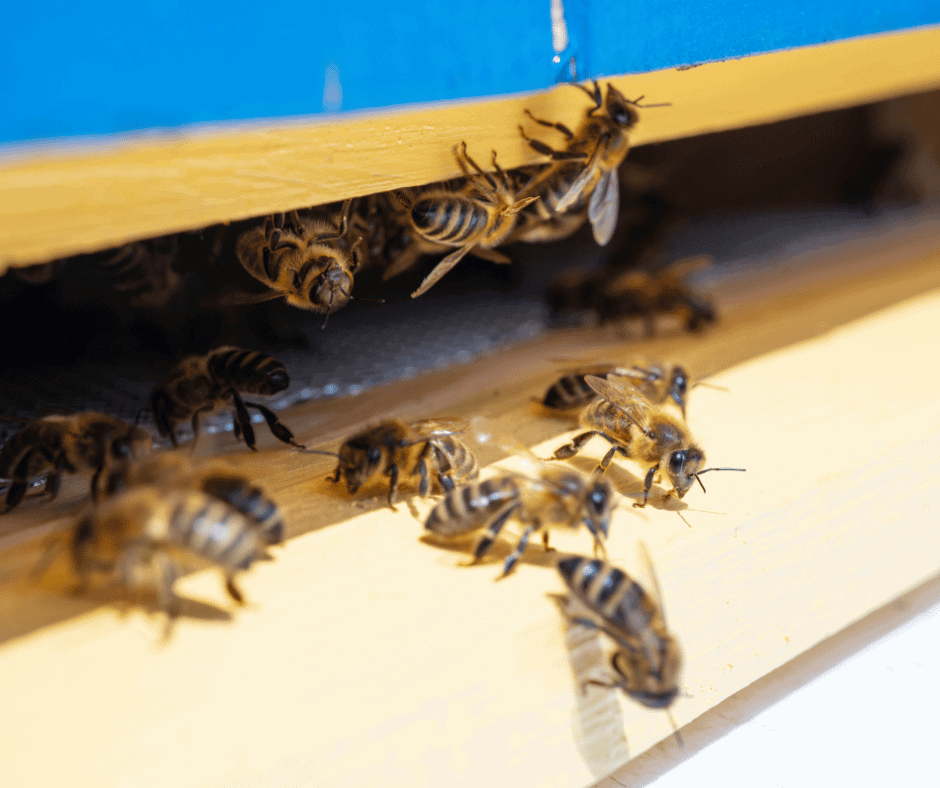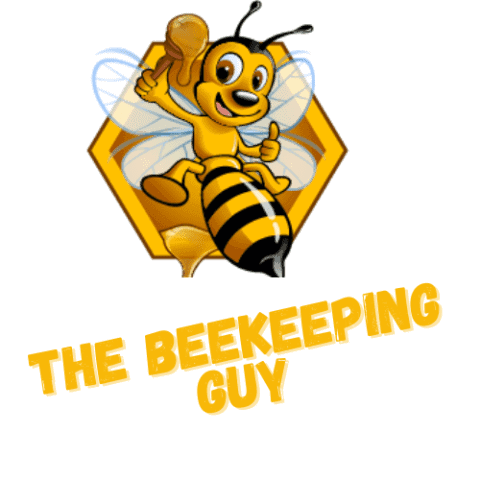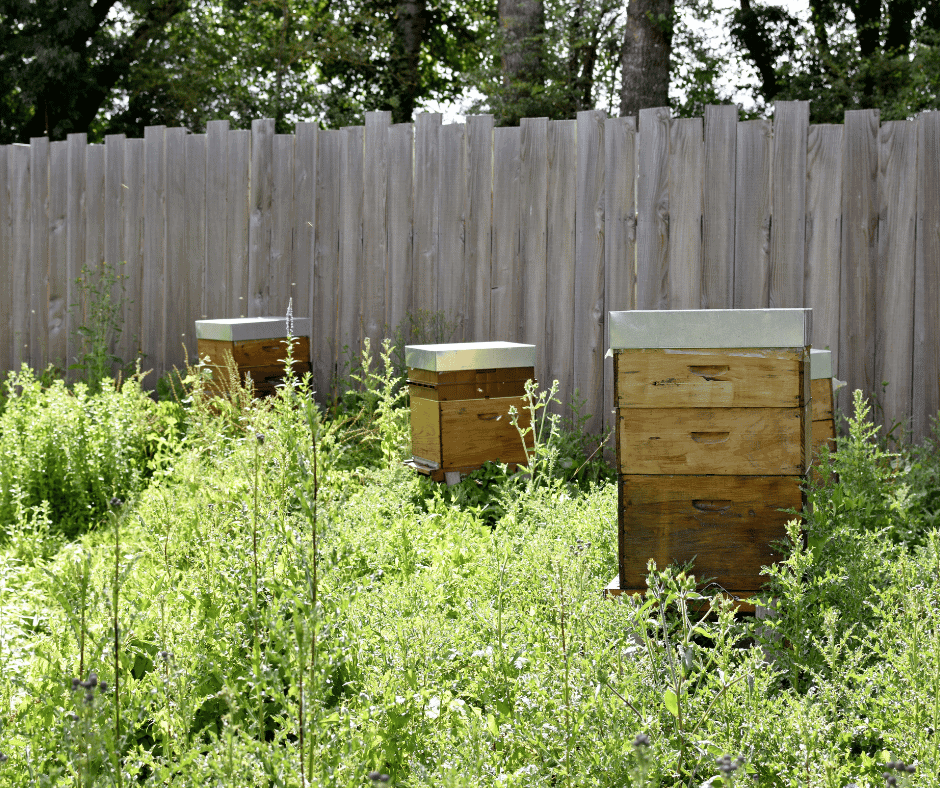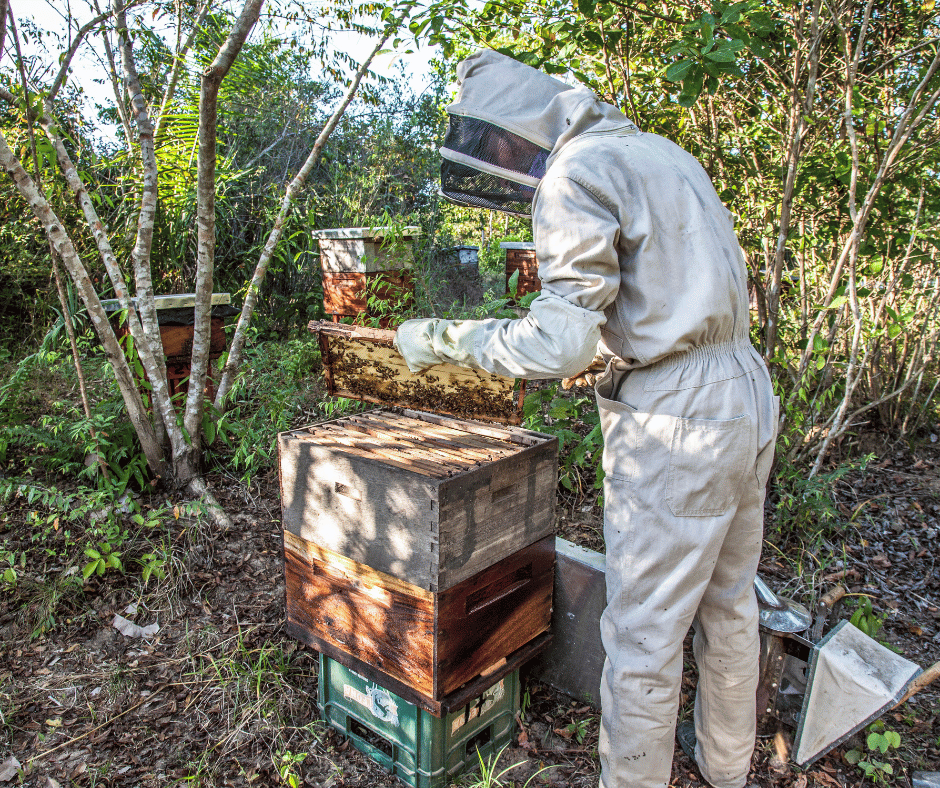
Do you have a beehive, but are worried about it being robbed? Robbing can cause serious problems for your hive and the bees within. It’s important to take steps to prevent robbing from happening in order to ensure the safety of your hive. In this article, we’ll provide tips on how to avoid robberies taking place at your beehive.
Are you ready to keep those robbers out? We’ve got some great ideas that will help make sure your hives remain safe and secure! From installing mesh guards around the entrance to ensuring there is plenty of food available nearby, these simple steps can dramatically reduce the chances of a robbery occurring.
Read on and find out what else you should do to protect your bee colony from potential perils!
Nobody wants their hard work to go up in smoke due to thieving intruders. Taking precautions now can save time, money, and stress down the road. Plus, with a little extra effort, you’ll know that your beloved bees are safe and sound inside their home sweet home – without having to worry about any unwelcome visitors invading their space!
Table of Contents
Definition And Types Of Robbing
Robbing is an undesirable behavior performed by honeybees that can be detrimental to a hive. It occurs when bees are driven by their natural instinct to collect nectar and pollen from other hives, taking it for themselves instead of bringing back what they find to their own colonies. So how do you tell if bees are being robbed? There are several signs of robbing, which we’ll cover in the next section.
When robbing takes place, it generally falls into one of two categories: aggressive or non-aggressive. In aggressive robbing, scout bees will actively search for weaker hives nearby and encourage more robust members of the colony to join them in attacking.
Non-aggressive robbing usually happens during times when resources like food sources and water become scarce; worker bees may take advantage of neighboring hives with larger stores than theirs. This type of stealing tends not to involve as many individuals as aggressive stealing does but still poses a threat nonetheless.
Let’s move on now to discussing how exactly this can be done.
Identifying The Signs Of Robbing
Robbing is one of the greatest threats to our beehives and can take a toll on their health. We must keep an eye out for signs that might indicate robbing in order to prevent it from happening. The most obvious sign of robbing is increased bee activity around the hive entrance.
Another giveaway sign of robbing is if you see any dead bees outside your hive as well as bits of wax scattered about the area. These pieces will not match up with the combs inside your hive and are likely evidence that other bees have been trying to get at its resources. Also, check for larvae thrown onto the ground surrounding the hive entrance – these too are potential indicators of robbing activity occurring within your hive!
If we want to protect our hives from robbers, then learning how to identify these signs is essential. Once we know what’s going on, then we can move on to figuring out how can we prevent bees from entering and stealing honey from our hardworking colonies!
Bee-Proofing Your Hive

Now that you have identified the signs of robbing, it’s time to take action and bee-proof your hive. To do this, you’ll need to make sure there are no easy entry points for intruders. One way to achieve this is by using entrance reducers or guards at the front of the hive. This will help reduce any potential access points while also making it difficult for robbers to get inside.
In addition, bees can be surprisingly aggressive when they feel threatened; they know exactly how to deal with intruders! They form a protective barrier around their home in order to keep out unwanted visitors and attack anyone who tries to enter uninvited.
A great way to discourage this behavior is by adding extra ventilation holes near the top of your hive as well as setting up a guard box filled with guard bees outside the main entrance. That way, if an intruder does try to breach your defenses, they’ll have a much harder time getting past these additional layers of protection.
Finally, you should always check on your hive from time to time just in case something has gone wrong and robbers have managed to infiltrate your home sweet home. Regular maintenance is essential in keeping your colony safe and healthy – so don’t forget about them! By implementing these strategies, you can ensure that your hive remains safe from robber bees and other pests looking for an easy meal. Now let’s explore some more ways we can further secure our hives – such as entrance reducers and guards…
Entrance Reducers And Guards

Entrance reducers and guards are essential for preventing robbing in a beehive. These two methods can help reduce the number of bees entering your hive, which will make it harder for robber bees to access your honey stores. Here are three key ways to use entrance reducers and guards:
- Install an entrance guard on top of the front door of the hive. This will prevent robber bees from directly accessing the interior of the hive by flying through the normal entryway.
- Use an entrance reducer to limit the size of the opening that allows other bees into your hive. By making this opening smaller, you create another obstacle between robbers and your honey stores.
- Set up multiple entrances around your hive so that there is more than one way for worker bees to enter and leave with nectar or pollen. If robbers come across these alternative entries, they may not realize what’s going on and avoid attacking altogether.
With diligent effort, using entrance reducers and guards can go a long way toward keeping robber bees away from your hives. Now let’s look at how implementing different feeding strategies can further discourage Robbing behavior.
Feeding Strategies To Discourage Robbing
To discourage robbing in your beehive, you should consider implementing some feeding strategies. Providing ample amounts of food to the colony can help dissuade other bees from raiding it for resources.

Supplemental feeders are an easy and effective way to provide extra nourishment; these feeders can be kept close by or placed outside the hive. If possible, try to keep them away from places with a lot of activity like footpaths or roads so that they’re not exposed to too much traffic.
The type of food used is also important when attempting to prevent robbing. Honeybees prefer high-energy sources like sugar syrup or pollen patties over watery options such as honeydew melons. Utilizing stronger scented foods may also prove beneficial since scent plays a role in bee communication and could potentially act as a deterrent against robbers.
Additionally, if there’s a lack of natural nectar sources nearby, providing supplemental feeders year-round can help ensure the health and survival of your colony during times when resources are scarce.
By taking steps such as providing adequate nutrition through supplemental feeds and using stronger scented foods where applicable, you’ll reduce the likelihood of robbing occurring in your hive.
Requeening And Rehiving

Requeening and rehiving are two of the most effective methods to prevent robbing in your beehive. Requeening involves replacing a colony’s queen bee with a new, young one. This will help create healthier hives as the new queen is able to lay more eggs than an aged queen. It also helps reduce the amount of swarming behavior that can lead to robbing.
Rehiving is similar but instead of just replacing the old queen, you completely replace the entire hive – all frames, honeycomb, and bees included. The new hive should have plenty of room for expansion and be built where there are fewer other colonies around it. By doing this regularly you can ensure that your colonies remain healthy, strong, and better protected against robbers.
Both these techniques require careful planning and preparation if they’re going to work successfully. Consider using specialized equipment such as screened bottom boards or entrance reducers when requeening or relocating hives; not only do these help protect from predators outside, but they also make it easier for workers inside to guard their resources against robbers.
Following proper safety protocols will go a long way toward protecting your investment and keeping your hives safe from thieves. With some care and attention, these strategies can become part of your regular maintenance routine and keep your apiary secure for years to come!
It’s important to note however that while requeening and rehiving are helpful tools when safeguarding against robber bees, they must be used in combination with other tactics like scent marking or pheromones for maximum protection.
Use Of Scents And Pheromones
Now that we have discussed requeening and rehiving, let’s explore another method to prevent robbing in your beehive: the use of scents and pheromones. Pheromone-based deterrents are a great way to reduce robber bees from entering your hive – they can detect the smell of their own species before they even enter.
By introducing artificial scent molecules into the environment surrounding your hive, you can create an invisible barrier that will discourage robbers from entering. Additionally, it is important to keep bee colonies within close proximity together so as not to attract unwanted pests.
The most common type of pheromone used for this purpose is called queen mandibular pheromone (QMP). This chemical compound is naturally produced by honeybee queens and helps with communication between colony members. When artificially introduced into the air around a hive, QMP creates a powerful repellent effect on potential robbers.
It also stimulates worker bees’ defensive behavior against intruders. Other options include using synthetic pheromones such as ApiGuard or BeeSafe which mimic natural compounds found in healthy hives and help deter potential predators. These products should be applied according to manufacturer instructions for best results.
In addition to using manufactured products, there are some simple steps one can take when trying to protect their apiary from robbers. Keeping hives clean and free of debris can help reduce odors that could potentially draw robber bees nearby; adding some windbreaks like evergreen trees near each entrance may also work wonders if done correctly.
Lastly, don’t forget about personal safety gear like gloves and veils when inspecting colonies – these basic precautions go a long way toward protecting both you and your bees! To further secure your hive, installing a division board is recommended…
Installing A Division Board
Installing a Division Board is the simplest way to help deter robbing from your beehive. This device, which looks like a thin sheet of wood or metal, can be placed between two hives and provides bees with added protection from robber bees. It acts as an extra barrier that robbers must cross in order to access honey within the hive. The division board also helps prevent bee fights by creating separate areas for each colony to operate without interference from outside sources.
In addition, installing a Division Board will also reduce the amount of time you spend defending your hives against robbers. By adding this additional layer of defense, you won’t have to constantly monitor your colonies and check for signs of robbing behavior. Instead, you can relax knowing that your hives are better protected than they would be without the use of a Division Board.
Division Board Video
The installation process itself is fairly straightforward – all you need is some basic tools and minimal DIY skills! Placing the Division Board between two active hives should take no more than an hour and it’s definitely worth doing if you want peace of mind when managing your beekeeping operation.
With proper placement, these boards can provide long-term protection from potential robbers and greatly reduce the chances of any losses due to theft or fighting among competing colonies.
From here we move on to exploring how positioning hives strategically can further minimize risk…
Positioning Hives Strategically
Now that you have installed a division board in your beehive, positioning the hives strategically is the next step towards preventing robbing. Placement of your hive or hives can go a long way to reduce the risk of robbing and help keep your bees healthy and productive.
To position hives effectively, consider both their environment and location relative to other beehives. First, select an area with enough sunlight for optimal warmth without being too hot during the summer months.
The ideal temperature range should remain between 75-90 degrees Fahrenheit throughout the year. Additionally, look for areas with adequate protection from wind, precipitation, and pests as these elements can cause significant damage to bee colonies over time.
| Environment | Location Relative To Other Hives | Advantages |
|---|---|---|
| Enough Sunlight | Isolated From Others | Optimal Temperature Range & Protection |
| Not Too Hot | Close Proximity | Easier Pollination Opportunities |
| Protection From Wind/Precipitation/Pests |
When selecting a spot to place your colony(s), think about how they will interact with neighboring hives or plants if placed close together. Bees tend to visit flowers within two miles of their home so having multiple hives located near one another increases pollination opportunities while also allowing them access to more resources such as nectar and water sources shared by each hive.
However, when locating separate colonies far apart from one another ensure there are no obstructions blocking flight paths between them; this will allow easy navigation for incoming bees looking for food sources that may not be available at their own hive thereby increasing the chances of guarding against robbers attempting to steal honey.
By following these guidelines when positioning your hive(s) you’ll create an ideal environment for successful beekeeping endeavors while protecting against potential threats like robberies.
Providing adequate ventilation is essential for maintaining healthy colonies; this section covers how best to accomplish that goal given specific conditions around your apiary site.
Providing Adequate Ventilation
Robbing can be a major problem in beekeeping, and it’s important to take steps to prevent it. One of the most effective measures is providing adequate ventilation for your bees. This will help ensure that there’s enough air circulation inside the hive so the temperature stays cool, discouraging robbing activity.

Your ventilators should be placed at least three feet above ground level and close to the entrance – this will encourage maximum airflow when opening or closing the hives. Make sure that any vents you install are large enough for easy passage of air but not too big – otherwise, they won’t do their job properly!
Additionally, if possible, locate your hives on higher ground where there is more wind; this will also aid in increasing ventilation levels in your hive.
Finally, taking these necessary steps to provide good ventilation means fewer chances of robbers targeting your precious bees. As a result, you’ll have healthier colonies with plenty of resources to thrive throughout the year.
Starting off by setting up feeders at an alternate location can further protect your hive from potential robbery risks.
Setting Up Feeders At An Alternate Location
Setting up feeders at an alternate location is a great way to reduce the risk of robbing your beehive. This strategy helps decrease competition for food sources and can even spread out foraging activity among other areas of your property.
To get started, you’ll want to place the feeder away from the hive—at least 50 feet or more if possible. Fill it with sugar syrup or another type of high-energy food source that will attract bees from other hives nearby. Make sure there are no trees close by where robbers could hide as well.
If this approach works, you should see fewer bees at the main hive entrance and more visiting the new feeder site instead over time. However, it’s important to keep a watchful eye on both locations to ensure that potential robber bees don’t overwhelm them either!
You may need to move or add additional feeders near entrances that are still receiving heavy traffic after several weeks of use.
Robbing prevention takes vigilance but feeds placed elsewhere can really help minimize competition around your hive and give its occupants a better chance of survival during times when resources are scarce or difficult to find naturally.
It’s also worth noting that while setting up these alternative sites can provide some relief, they won’t completely eliminate all threats so you need to be monitoring the hive closely.
Monitoring Activity Around The Hive
Monitoring activity around the hive is an important part of preventing robbing. To start, it’s a good idea to make sure there are no trees or structures too close in proximity that could be used as cover for robbers. It’s also wise to look out for any new bee colonies near your own- if you notice one, take measures to protect yours from potential robbing.
In addition to reducing risk factors, monitoring can help alert you when robbers do arrive at your hives. By observing your bees on a regular basis, you may be able to spot signs of robbing before they cause significant damage.
It’s also helpful to scout the area surrounding the hive periodically throughout the season so that robbers don’t have time to establish their presence without detection. This helps ensure ongoing security and keeps your colony safe from harm. With vigilance and proactive protection strategies, you can help prevent robbery in your beehive and maintain a healthy environment where your bees thrive!
Camera surveillance systems provide an extra layer of safety against robber bees. They give beekeepers another way to monitor activity around their hives and ward off any unwanted intruders…
Camera Surveillance Systems
The use of camera surveillance systems is a great way to prevent robberies in beehives. Here are three reasons why:
- Cameras can detect intruders before they enter the hive, allowing for a greater chance of prevention.
- They provide 24/7 monitoring and recording, giving you peace of mind even when you’re not there to watch your hives yourself.
- You can view live footage from anywhere with an internet connection, making it easy to stay informed about what’s happening at your beehive site even if you’re away on vacation or business trips.
Camera surveillance systems also offer additional benefits such as motion detection alerts that help alert beekeepers to potential threats quickly and efficiently. With these features, beekeepers have greater control over their beehive safety than ever before.
Additionally, they come equipped with night vision technology so that bees aren’t disturbed by light exposure during crucial times like honey extraction processes.
By taking advantage of this powerful security tool, beekeepers can rest assured that their hives are being protected round-the-clock against robbers and other dangers. Surveillance cameras give beekeepers the confidence they need to keep their colonies safe while keeping them informed on any suspicious activity near their apiaries.
With this level of protection in place, beekeeping becomes more secure and enjoyable than ever before – leaving the hard work up to the bees! Now let’s turn our attention to artificial swarm cells as another option for protecting your hives…
Artificial Swarm Cells
Using artificial swarm cells is an effective way to prevent robbing in your beehive. It’s a simple, inexpensive solution that can quickly help protect the hive and its resources from being taken away by robbers.
Artificial swarm cells are essentially small containers filled with nectar or honey which provide food for bees during times when it isn’t much available naturally. The container lures robber bees away from the main hive and encourages them to feed on the supplied nectar instead of stealing it from other hives.
The artificial cell also serves as a trap, preventing robber bees from entering the hive through any open entrances or cracks in the walls. This helps keep out unwelcome intruders who may otherwise take advantage of weak spots to steal valuable resources from within.
Artificial Swarm Video
Additionally, these cells can act as a deterrent against large numbers of robbers who would otherwise target unprotected hives for their honey supply. By enticing thieves elsewhere, you’ll have peace of mind knowing that your precious colony won’t fall victim to thievery.
Installing artificial swarm cells near entranceways is an easy way to reduce robbery in your beehive without having to resort to aggressive tactics like killing those responsible or setting up traps around the perimeter.
Not only will this save time and money-it could even save lives if done correctly and timely! So don’t wait any longer; start protecting your bee population today with the use of artificial swarm cells!
Conclusion
Robbing is an issue that every beekeeper should take seriously. It can result in a significant loss of resources and even the death of your bees if not properly managed. With the right strategies, though, you can protect your hive from robber bees.
Firstly, bee-proofing your hive with entrance reducers and guards will help to deter robbers. Additionally, feeding strategies like providing food away from the entrance or using artificial swarm cells can help discourage robbing behavior. Finally, controlling varroa mites and monitoring activity around the hive are also effective methods for preventing robbing in your beehive.
All in all, by following these guidelines you’ll be able to keep thieves at bay and ensure a healthy colony of honeybees! I’m confident that with proper preparation and knowledge, you’ll be able to prevent robbing in your very own beehive.



